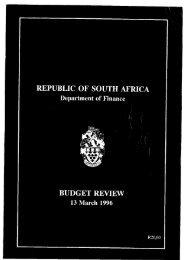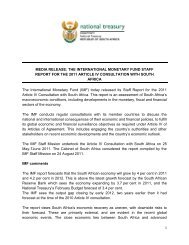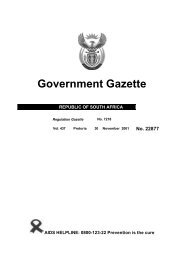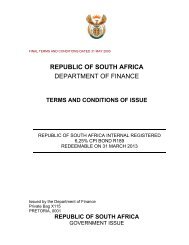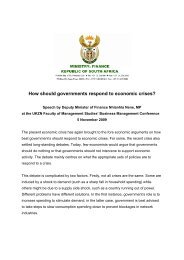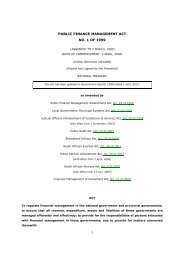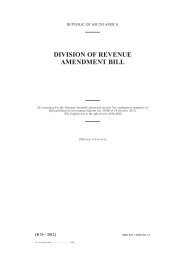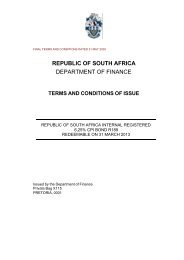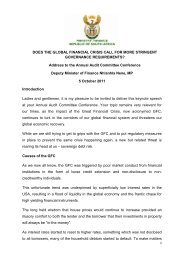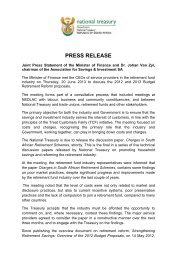1998 SOUTHERN AFRICA ECONOMIC ... - National Treasury
1998 SOUTHERN AFRICA ECONOMIC ... - National Treasury
1998 SOUTHERN AFRICA ECONOMIC ... - National Treasury
Create successful ePaper yourself
Turn your PDF publications into a flip-book with our unique Google optimized e-Paper software.
A NG OL A<br />
of GDP in 1996. E x p o rts increased by 36 percent in 1996 to<br />
USD5.1 billion, m a i n ly because of a 12 percent increase in oil<br />
e x p o rt volumes and a 19 percent increase in international oil<br />
p r i c e s . R e c o rded diamond export receipts increased by 59<br />
p e rc e n t . Data on imports are limited, but present estimates<br />
point to an 18 percent rise in 1996 to about USD2.2 billion. T h e<br />
c apital account showed a surplus of some USD106m in 1996,<br />
owing mainly to higher loan disbursements. The above<br />
explained trend was expected to continue in 1997 with the<br />
exception of international oil price levels which we re expected<br />
to dro p.The continued decline in oil prices seen so far in <strong>1998</strong><br />
indicates that even if production incre a s e s ,A n gola is like ly to<br />
experience a decline in export reve nues in dollar terms this<br />
ye a r.<br />
A n go l a ’s external debt was reduced from USD13.7 billion at<br />
end-1995 to USD10.1 billion at end-1996, as a result of the<br />
cancellation of 70 percent of the stock of debt and arrears to<br />
the Russian Fe d e r a t i o n ,and the rescheduling of the remaining 30<br />
p e rc e n t . In add i t i o n , USD1.2 billion of short-term debt to<br />
Po rtugal was conve rted into medium- and long-term debt. A t<br />
the end of 1997, A n go l a ’s external debt was equivalent to 129<br />
p e rcent of exports of goods and non-factor serv i c e s , and its<br />
d e b t - s e rvice ratio amounted to 33 perc e n t .<br />
The much discussed IMF programme was not instituted in 1997<br />
as had been anticipated. The IMF is due to visit A n gola for art i c l e<br />
IV consultations in May <strong>1998</strong>,but it is unclear what the outcome<br />
of this visit will be. The IMF has expressed concern at the lack<br />
of transparency with re g a rd to the handling of oil export<br />
p ro c e e d s .<br />
Financial Institutions<br />
Since 1991, the A n golan government has been attempting to<br />
c reate a more efficient and diversified banking system. U n d e r<br />
these new re forms Banco Naçional de A n gola now acts solely as<br />
a central bank,being responsible for monetary policy and issuing<br />
of bank notes and coins. As a banker of the government it<br />
administers the tre a s u ry ’s account, e f fecting payments and<br />
collecting tax income on behalf of the authorities. The bank is<br />
also co-responsible for the fo r mulation of monetary and<br />
exchange rate policies and is largely responsible for the<br />
e xecution of these policies. H oweve r, m o n e t a ry policy is in<br />
practice determined by the gove r n m e n t ’s economic team which<br />
includes the Minister of Finance, the Governor of the central<br />
bank and the Minister of Planning, and is headed by the latter.<br />
F u rther developments are the arrival of fo reign banks who have<br />
established offices in the country. P roblems still exist, h oweve r,<br />
in that credit facilities for businesses are inadequate and large<br />
p a rts of the country, e s p e c i a l ly small tow n s , a re underbanke d .<br />
T h e re are five commercial banks in A n go l a .Two are stateow<br />
n e d : Banco de Poupança e Crédito and Banco de Comérc i o<br />
e Industria, and three Po rtuguese private banks: Banco de<br />
Fomento e Exterior, Banco Totta e A ç o re s ,Banco Po rtuguês do<br />
A t l ã n t i c o.<br />
M o n ey and capital markets are still poorly developed and the<br />
i n formal money market is thus used extensive ly. The first steps<br />
to create a capital market have been take n . A task fo rce has<br />
been set up to discuss primary legal and economic fo u n d a t i o n s<br />
and to pre p a re a basis for the creation of a Capital Marke t<br />
S u p e rv i s o ry Commission. The task fo rce will also analyse the<br />
d e regulation and restructuring of the insurance industry, and to<br />
a n a lyse debt restructuring and privatisation issues.<br />
E x c h a n ge Control and Currency Conve rt i b i l i t y<br />
The A n golan Kwanza is not conve rt i b l e, and exportation of<br />
domestic currency is pro h i b i t e d . Banco Naçional de A n go l a<br />
publishes two sets of exchange rates on a daily basis - one fo r<br />
its transactions with commercial banks and one for transactions<br />
b e t ween the commercial banks and economic agents. Fo re i g n<br />
c u rrency accounts are permitted, into which fo reign curre n c y<br />
(in cash, t r avellers cheques or fo reign payment orders) may be<br />
d e p o s i t e d . Chequebooks may not, h oweve r, be issued against<br />
these accounts. Exchange control regulations are fairly strict.<br />
Dividends earned by fo reign investors may be taken out of<br />
A n gola if the investment in the resident company exceeds USD<br />
2 5 0 , 0 0 0 .Tr a n s fers of personal capital are permitted only on a<br />
c a s e - by-case basis. All capital transfers are subject to licensing<br />
and contro l .<br />
Fo reign Trade<br />
A n gola has come to depend ove r w h e l m i n g ly on oil for its<br />
e x p o rt earnings, with the USA being the main market fo r<br />
e x p o rt s .In 1996,crude oil made up over 90 percent of export s .<br />
T h e re is much underutilised potential in other are a s , h oweve r,<br />
such as diamond mining, c o f fe e, and fishing.The promotion and<br />
d i versification of exports have been recognised by the<br />
goverment as one of the ways to facilitate grow t h .<br />
Up until re c e n t ly, A n gola has had few trade ties with southern<br />
African countries. H oweve r, o p p o rtunities for trade with<br />
countries in the region have opened up. Relations with South<br />
Africa have improved during the 1990s, and there has been a<br />
notable increase in trade (especially imports) with South A f r i c a .<br />
Trade Liberalisation<br />
All imports and exports must be licensed by the Ministry of<br />
C o m m e rc e. An import license fee of 0.1 percent of the value of<br />
the imports is lev i e d , and import licenses are only granted to<br />
enterprises of proven cap a c i t y. E x p o rts of certain goods are<br />
p ro h i b i t e d .<br />
Fo reign Direct Inve s t m e n t<br />
Since 1994 the number of ap p rove d 2 ) p rojects have incre a s e d<br />
s u b s t a n t i a l ly. B e t ween 1990-1997 projects amounting to a total<br />
of USD800m we re ap p rove d . Most ap p roved investments are<br />
f a i r ly small, a round USD250,000, and half of all projects have a<br />
value of less than USD1m each. The largest single inve s t m e n t<br />
thus far amounted to USD120m. A large pro p o rtion (more than<br />
80 percent) of the invested amounts is used for imports of<br />
equipment and other go o d s ;the remainder for the purchase of<br />
assets in A n go l a .<br />
The geographical distribution of ap p roved investments show s<br />
that some 75 percent originate in Euro p e, fo l l owed by We s t<br />
Africa with 11 percent of all investments (mainly from Nigeria).<br />
Po rtugal is the single biggest inve s t o r. South African inve s t m e n t s<br />
a re slow ly incre a s i n g ,with Anglo American Corporation and De<br />
Beers making investments in 1997. Other South African firms<br />
h ave expressed intere s t ;some invo l vement in consumer go o d s<br />
has already been undert a ken by firms from South A f r i c a . C o c a -<br />
Cola has announced intentions to construct a plant to be<br />
opened north of Luanda in 1999, and De Beers and the state<br />
diamond company, E n d i a m a , will set up a diamond sort i n g<br />
operation in Luanda during <strong>1998</strong>.<br />
Privatisation Prog r a m m e<br />
The privatisation of state assets is part of the strategy that the<br />
A n golan government hopes to implement for the purpose of<br />
rebuilding the economy. Due to a number of pro b l e m s ,t h e<br />
privatisation process has not been as rapid as initially planned.<br />
B e t ween 1991 and 1997, a number of small and some mediumsize<br />
enterprises we re privatised, yielding gross reve nues of<br />
2 )<br />
Statistics for actual investments are difficult to obtain.The Inve s t m e n t<br />
Institute howeve r, keeps a re c o rd of all ap p roved inve s t m e n t s .<br />
23



